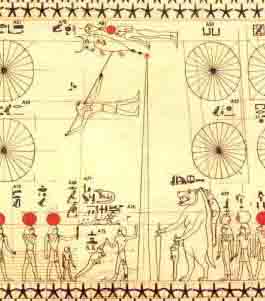![]()
![]()
xi. The Key to Ascension

The Great Pyramid is one of the seven wonders of the ancient world. Constructed in c. 2600 BC as a funerary monument for the Old Kingdom pharaoh Khufu (or Cheops), it is the triumph of 500 years of evolution in funerary architecture, beginning with simple burials in underground tombs and culminating with the perfect pyramid. Invariably, Egyptian funerary monuments were aligned north-south, a ritual act achieved with precision in the Pyramid Age. Finding true north was ceremonially determined during a ritual known as 'Stretching of the Cord', which involved the use of a specific star, or stars, in the northern night sky.
|
Following the pioneering work of English Egyptologist Gerald Wainwright during the 1930s, Czech Egyptologist Zbynek Zába wrote in 1953 that true north was found by the ancient Egyptians of the Pyramid Age using an alignment of stars in constellations found either side of the northern celestial pole. These were Cygnus and Ursa Major, which he identified as asterisms known in Ancient Egyptian astronomy as, respectively, dwn-'nwy, a falcon-headed god, and mšhtyw the bull, or ox thigh, additionally seen as the old foes Horus and Set, ever sparring around each other in the night sky. Zába's findings were subsequently verified by Livio Catullus Stecchini (1913-1979), the brilliant Italian mathematician and metrologist. The north-south meridian line was the key to ascension in Ancient Egyptian religion. It is a concept found in the Pyramid Texts, to be seen on the walls of pyramids from the Fifth to the Eighth Dynasties, with the sky-rope, or ladder. This linked the axis mundi, 'axis of the earth', with the cosmic axis, i.e. the northern celestial pole, providing us with a purpose for the northerly orientation of almost all pyramids and many more simple, so-called 'mastaba' tombs as well. |
The Northern Group of constellations including the falcon-headed god dwn-'nwy identified as Cygnus. |
Even though Thuban in Ursa Minor was Pole Star at the beginning of the Pyramid Age, after it had shifted too far to be classified under this title, the stars of Cygnus and Ursa Major would seem to have been used to mark out the line of cosmic ascension. This concept was also displayed on the ground. Some 17 kilometres (10.5 miles) due north of Giza is Ausim, the site of the ancient city of Letopolis. This was once the home of the priest of the sacred adze, used in the Opening of the Mouth ritual, which enabled the pharaoh to speak in the next world.
The celestial adze was equated primarily with the stars of Ursa Major, linking the constellation with Letopolis, an assumption confirmed in the knowledge that the symbol of its nome, or district, was the ox thigh. Yet if this was so, was there somewhere on this meridian line that represented the falcon-headed god identified with the stars of Cygnus?
![]()
![]()
